Economics Homework: Analyzing the Foreign Exchange Market Dynamics
VerifiedAdded on 2019/09/25
|17
|1998
|35
Homework Assignment
AI Summary
This document presents a comprehensive solution to a foreign exchange homework assignment. The solution begins with an analysis of how various transactions impact the private demand and supply of pounds sterling in the dollar-pound market, including the effects on price and exchange rate. It then delves into the dynamics of the $-£ foreign exchange market under a fixed exchange rate system, examining the Federal Reserve's intervention strategies in response to changes in US exports and the subsequent impact on the balance of payments, official reserves, and the money supply. The assignment further investigates the volatility of exchange rates over different periods, comparing the 1960s and 1980s, and considers firms' preparedness for currency devaluations. The solution also addresses the arguments for and against fixed and floating exchange rates, using the example of Asian economies after the 1997-98 financial crisis. Finally, it tackles arbitrage opportunities in the foreign exchange market and calculates the cost of buying Mexican pesos. References from academic journals and textbooks are also provided.
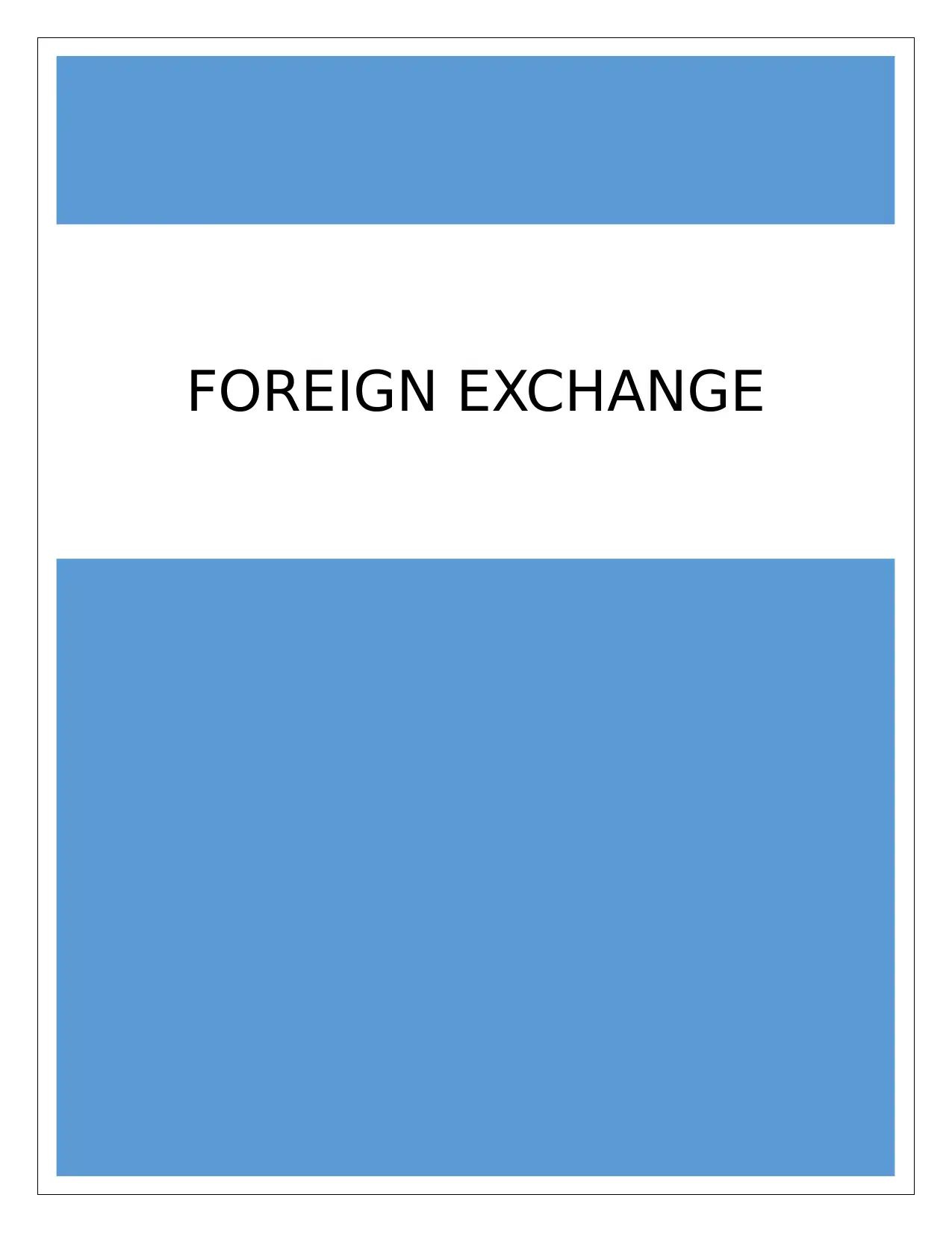
FOREIGN EXCHANGE
Paraphrase This Document
Need a fresh take? Get an instant paraphrase of this document with our AI Paraphraser
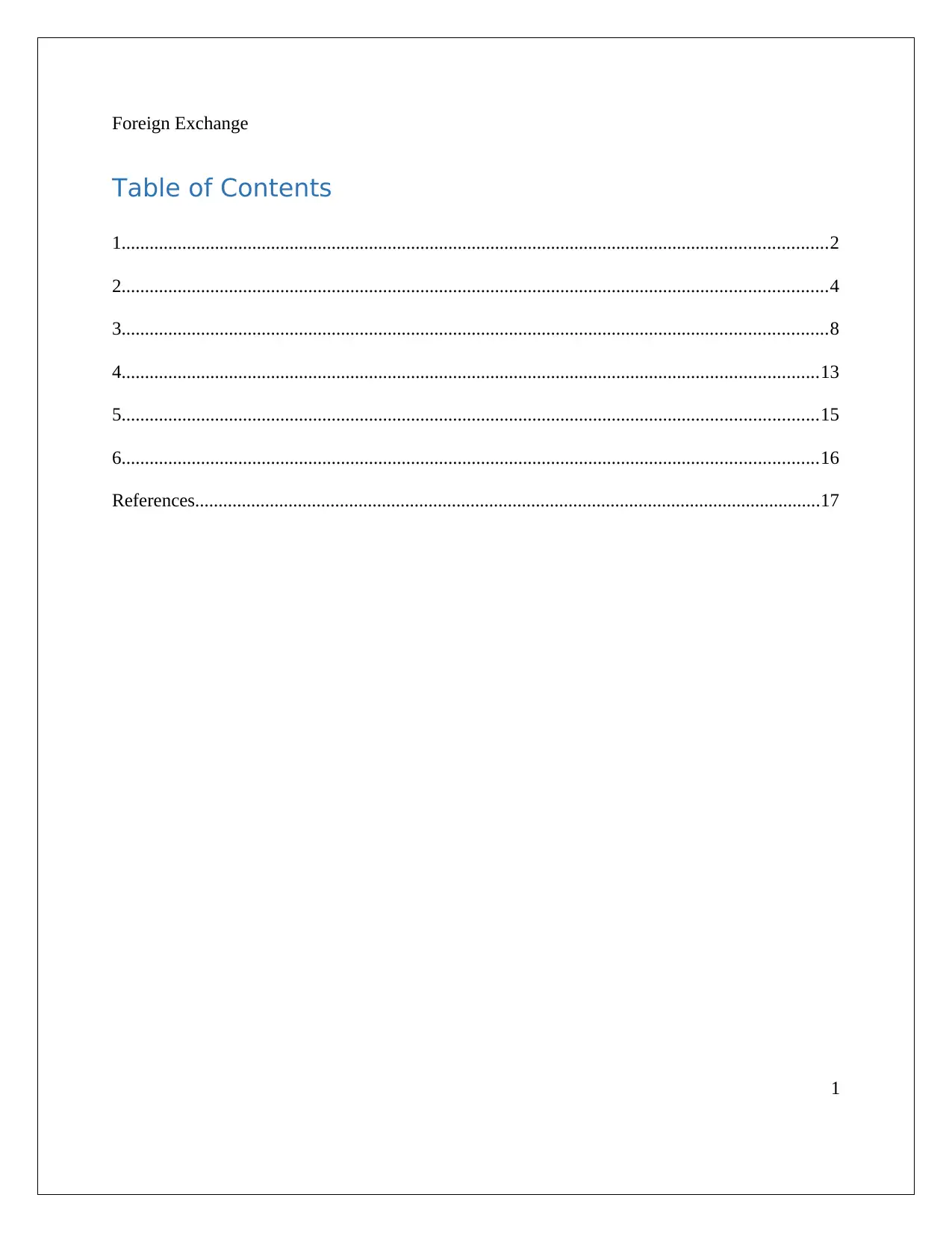
Foreign Exchange
Table of Contents
1.......................................................................................................................................................2
2.......................................................................................................................................................4
3.......................................................................................................................................................8
4.....................................................................................................................................................13
5.....................................................................................................................................................15
6.....................................................................................................................................................16
References......................................................................................................................................17
1
Table of Contents
1.......................................................................................................................................................2
2.......................................................................................................................................................4
3.......................................................................................................................................................8
4.....................................................................................................................................................13
5.....................................................................................................................................................15
6.....................................................................................................................................................16
References......................................................................................................................................17
1
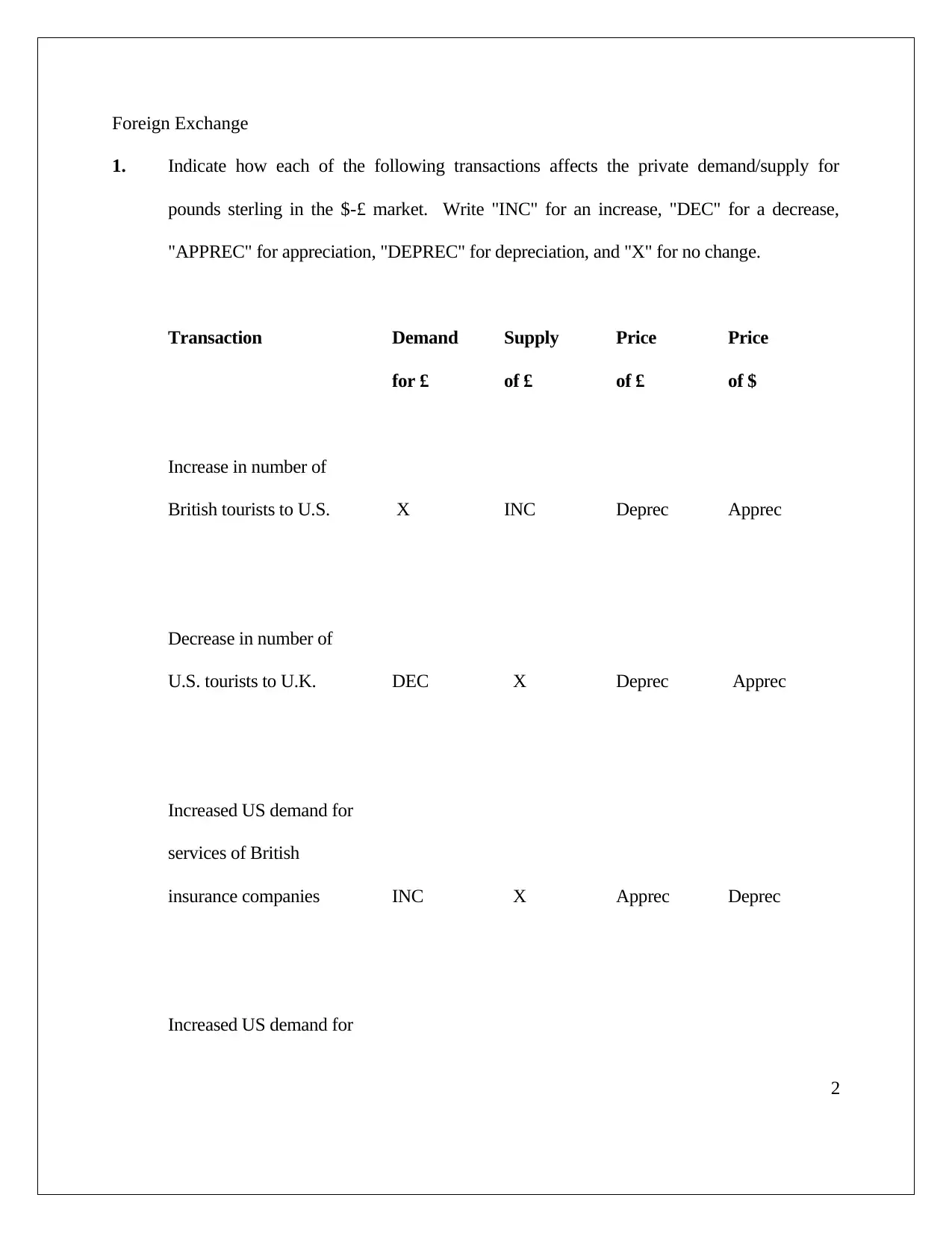
Foreign Exchange
1. Indicate how each of the following transactions affects the private demand/supply for
pounds sterling in the $-£ market. Write "INC" for an increase, "DEC" for a decrease,
"APPREC" for appreciation, "DEPREC" for depreciation, and "X" for no change.
Transaction Demand Supply Price Price
for £ of £ of £ of $
Increase in number of
British tourists to U.S. X INC Deprec Apprec
Decrease in number of
U.S. tourists to U.K. DEC X Deprec Apprec
Increased US demand for
services of British
insurance companies INC X Apprec Deprec
Increased US demand for
2
1. Indicate how each of the following transactions affects the private demand/supply for
pounds sterling in the $-£ market. Write "INC" for an increase, "DEC" for a decrease,
"APPREC" for appreciation, "DEPREC" for depreciation, and "X" for no change.
Transaction Demand Supply Price Price
for £ of £ of £ of $
Increase in number of
British tourists to U.S. X INC Deprec Apprec
Decrease in number of
U.S. tourists to U.K. DEC X Deprec Apprec
Increased US demand for
services of British
insurance companies INC X Apprec Deprec
Increased US demand for
2
⊘ This is a preview!⊘
Do you want full access?
Subscribe today to unlock all pages.

Trusted by 1+ million students worldwide
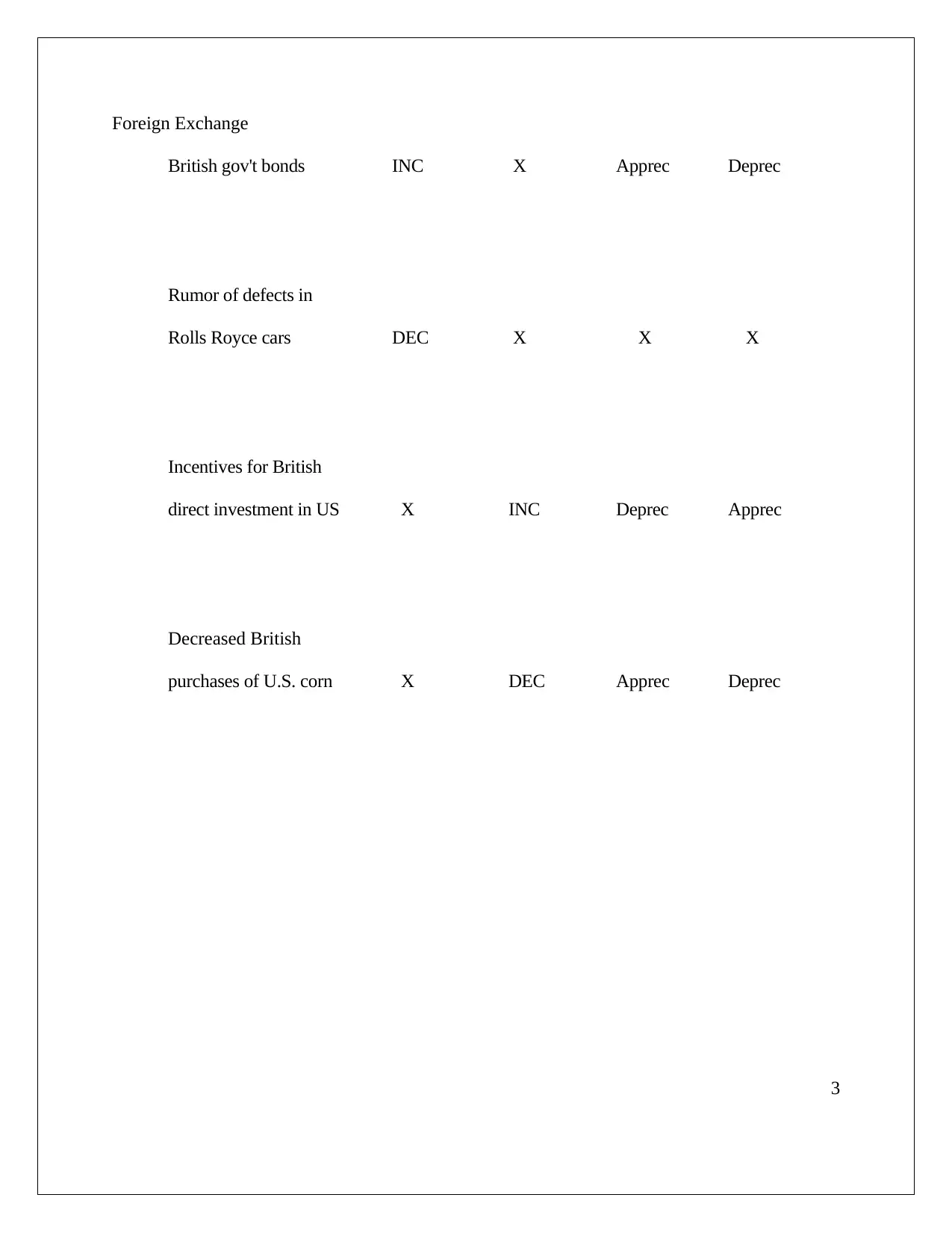
Foreign Exchange
British gov't bonds INC X Apprec Deprec
Rumor of defects in
Rolls Royce cars DEC X X X
Incentives for British
direct investment in US X INC Deprec Apprec
Decreased British
purchases of U.S. corn X DEC Apprec Deprec
3
British gov't bonds INC X Apprec Deprec
Rumor of defects in
Rolls Royce cars DEC X X X
Incentives for British
direct investment in US X INC Deprec Apprec
Decreased British
purchases of U.S. corn X DEC Apprec Deprec
3
Paraphrase This Document
Need a fresh take? Get an instant paraphrase of this document with our AI Paraphraser
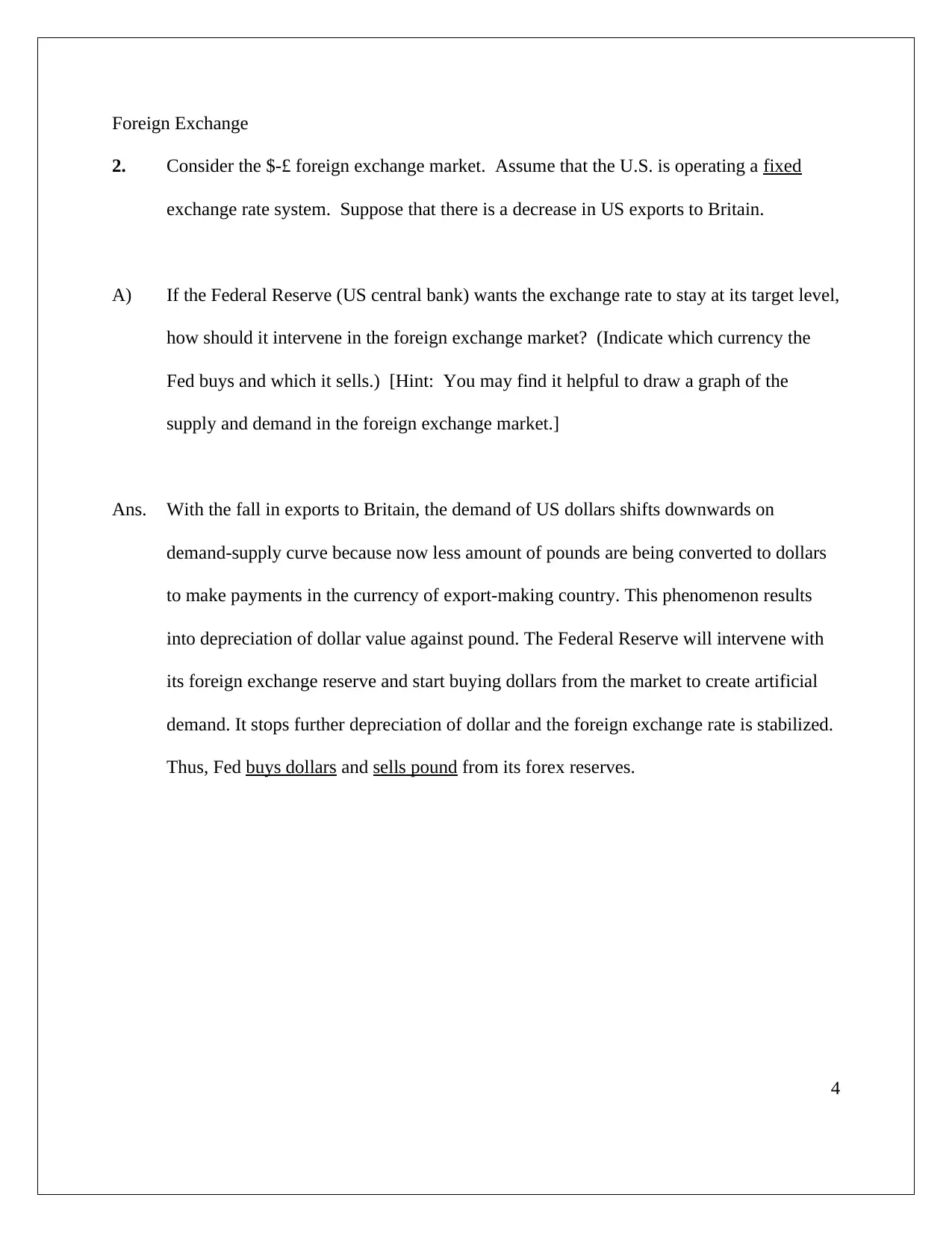
Foreign Exchange
2. Consider the $-£ foreign exchange market. Assume that the U.S. is operating a fixed
exchange rate system. Suppose that there is a decrease in US exports to Britain.
A) If the Federal Reserve (US central bank) wants the exchange rate to stay at its target level,
how should it intervene in the foreign exchange market? (Indicate which currency the
Fed buys and which it sells.) [Hint: You may find it helpful to draw a graph of the
supply and demand in the foreign exchange market.]
Ans. With the fall in exports to Britain, the demand of US dollars shifts downwards on
demand-supply curve because now less amount of pounds are being converted to dollars
to make payments in the currency of export-making country. This phenomenon results
into depreciation of dollar value against pound. The Federal Reserve will intervene with
its foreign exchange reserve and start buying dollars from the market to create artificial
demand. It stops further depreciation of dollar and the foreign exchange rate is stabilized.
Thus, Fed buys dollars and sells pound from its forex reserves.
4
2. Consider the $-£ foreign exchange market. Assume that the U.S. is operating a fixed
exchange rate system. Suppose that there is a decrease in US exports to Britain.
A) If the Federal Reserve (US central bank) wants the exchange rate to stay at its target level,
how should it intervene in the foreign exchange market? (Indicate which currency the
Fed buys and which it sells.) [Hint: You may find it helpful to draw a graph of the
supply and demand in the foreign exchange market.]
Ans. With the fall in exports to Britain, the demand of US dollars shifts downwards on
demand-supply curve because now less amount of pounds are being converted to dollars
to make payments in the currency of export-making country. This phenomenon results
into depreciation of dollar value against pound. The Federal Reserve will intervene with
its foreign exchange reserve and start buying dollars from the market to create artificial
demand. It stops further depreciation of dollar and the foreign exchange rate is stabilized.
Thus, Fed buys dollars and sells pound from its forex reserves.
4
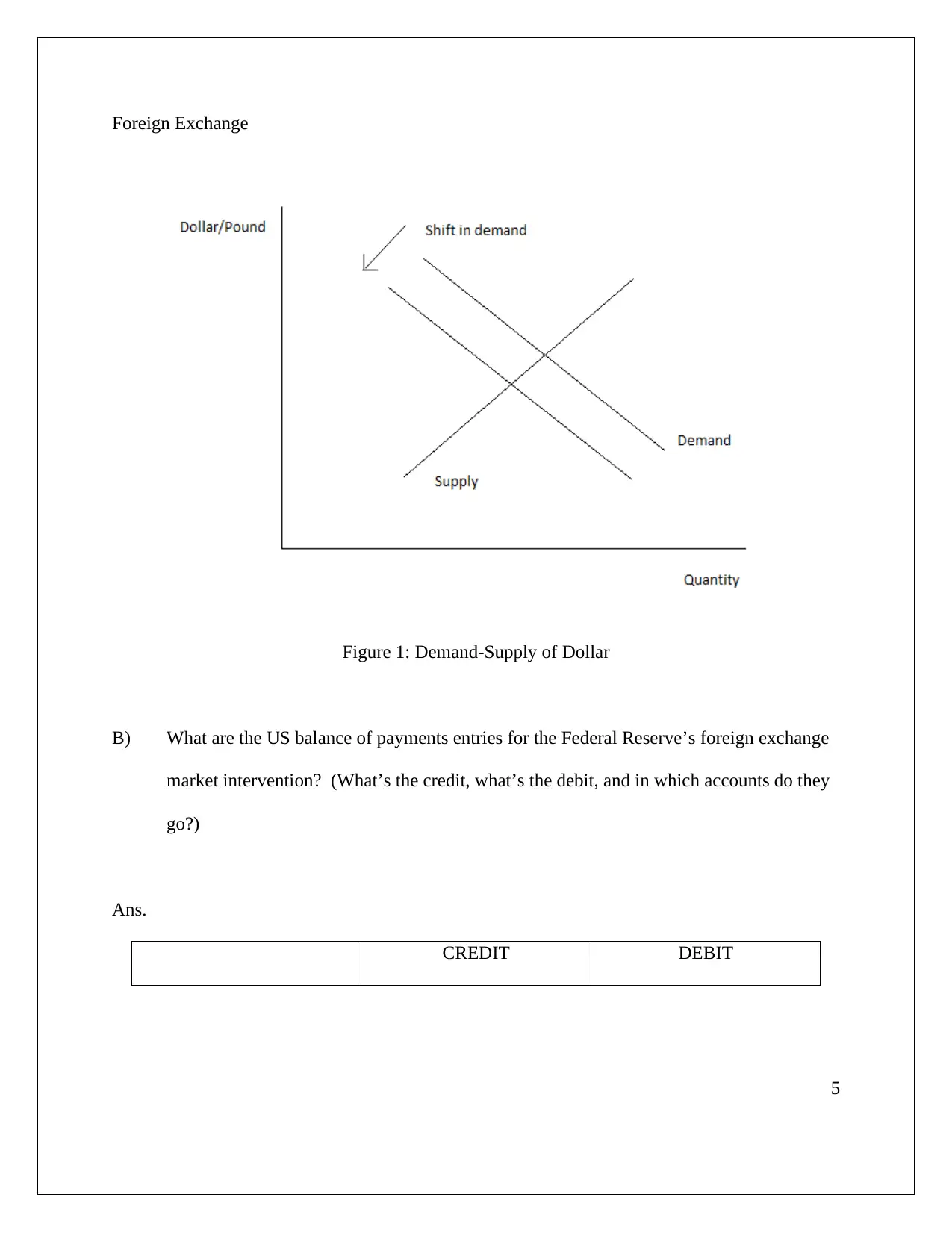
Foreign Exchange
Figure 1: Demand-Supply of Dollar
B) What are the US balance of payments entries for the Federal Reserve’s foreign exchange
market intervention? (What’s the credit, what’s the debit, and in which accounts do they
go?)
Ans.
CREDIT DEBIT
5
Figure 1: Demand-Supply of Dollar
B) What are the US balance of payments entries for the Federal Reserve’s foreign exchange
market intervention? (What’s the credit, what’s the debit, and in which accounts do they
go?)
Ans.
CREDIT DEBIT
5
⊘ This is a preview!⊘
Do you want full access?
Subscribe today to unlock all pages.

Trusted by 1+ million students worldwide
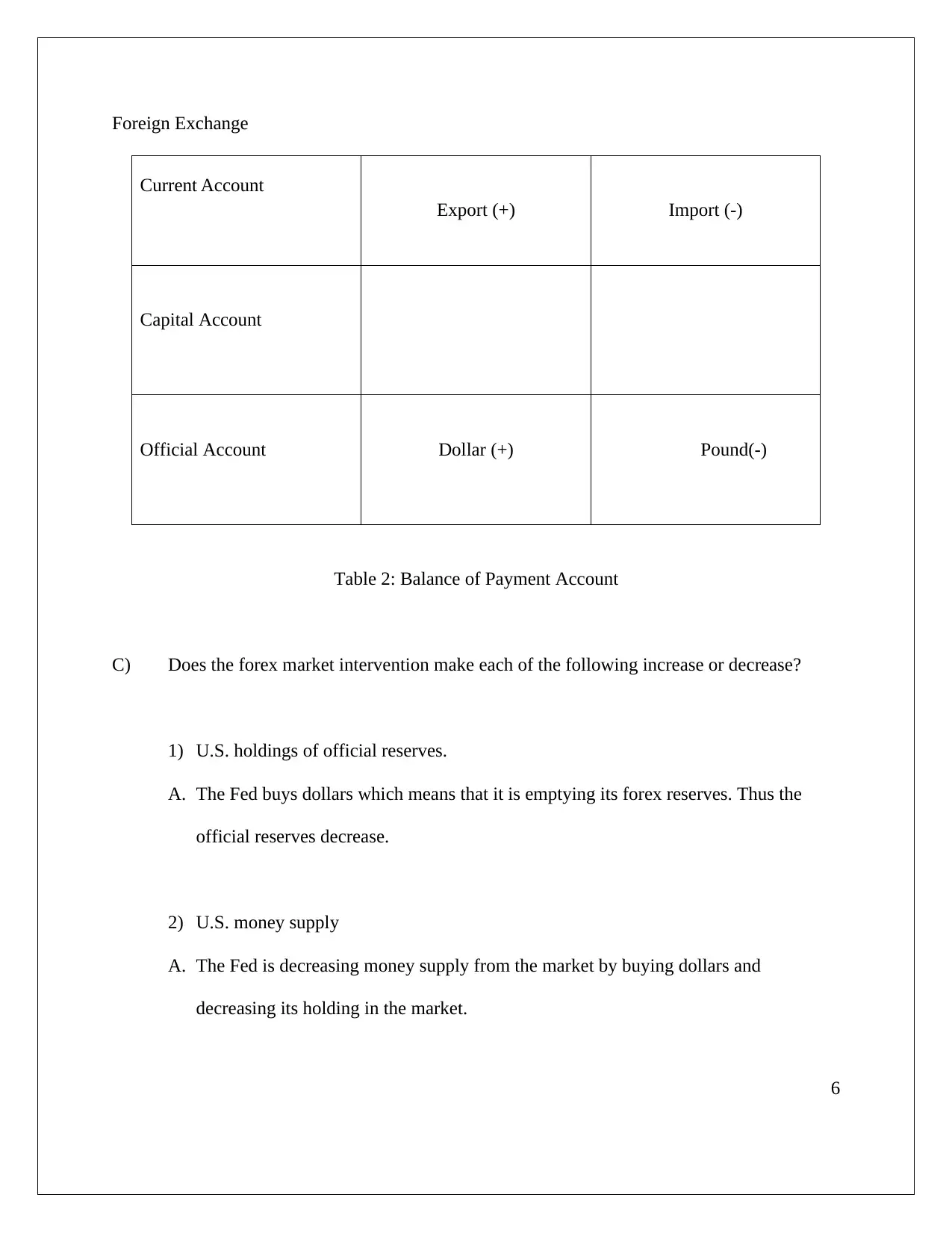
Foreign Exchange
Current Account
Export (+) Import (-)
Capital Account
Official Account Dollar (+) Pound(-)
Table 2: Balance of Payment Account
C) Does the forex market intervention make each of the following increase or decrease?
1) U.S. holdings of official reserves.
A. The Fed buys dollars which means that it is emptying its forex reserves. Thus the
official reserves decrease.
2) U.S. money supply
A. The Fed is decreasing money supply from the market by buying dollars and
decreasing its holding in the market.
6
Current Account
Export (+) Import (-)
Capital Account
Official Account Dollar (+) Pound(-)
Table 2: Balance of Payment Account
C) Does the forex market intervention make each of the following increase or decrease?
1) U.S. holdings of official reserves.
A. The Fed buys dollars which means that it is emptying its forex reserves. Thus the
official reserves decrease.
2) U.S. money supply
A. The Fed is decreasing money supply from the market by buying dollars and
decreasing its holding in the market.
6
Paraphrase This Document
Need a fresh take? Get an instant paraphrase of this document with our AI Paraphraser
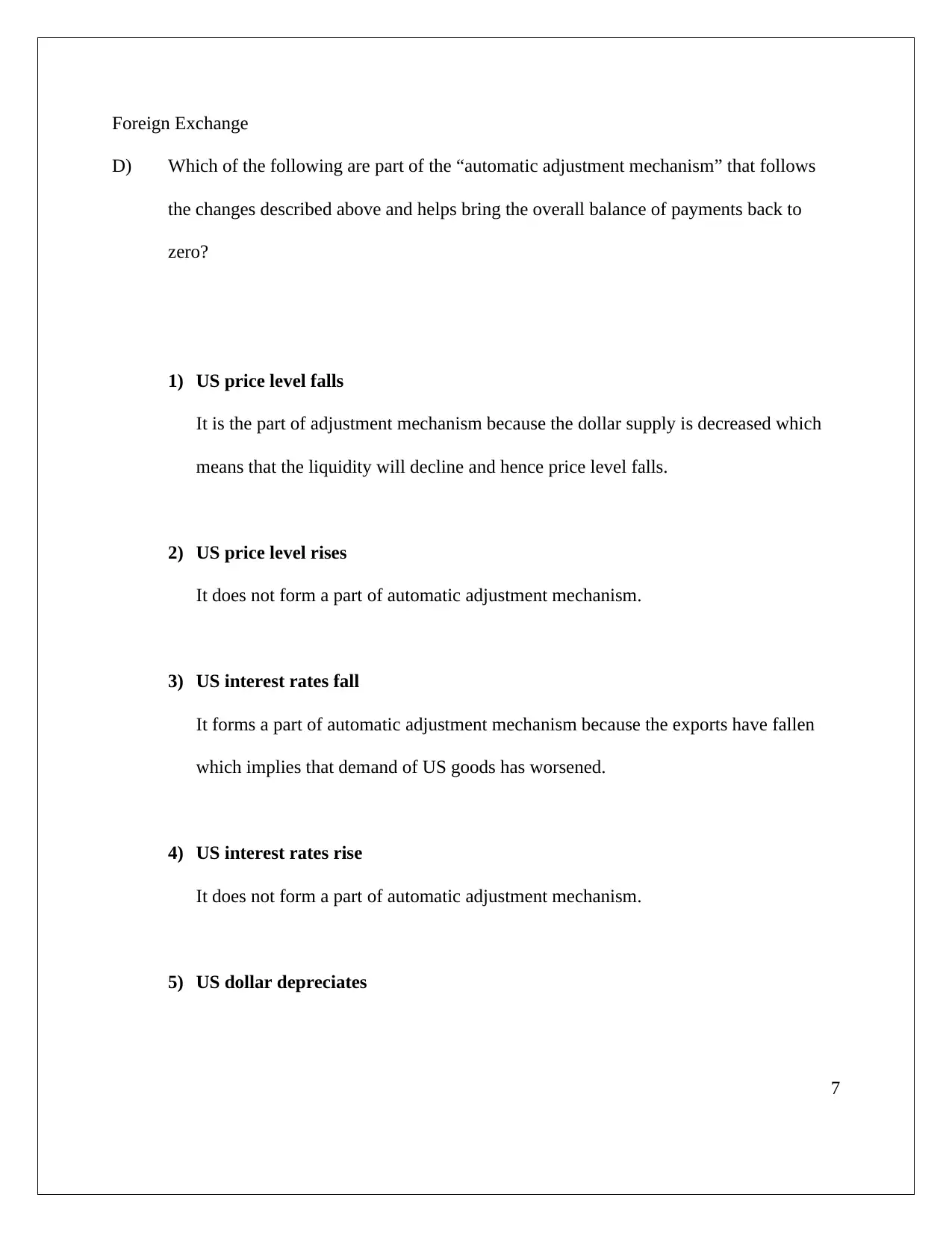
Foreign Exchange
D) Which of the following are part of the “automatic adjustment mechanism” that follows
the changes described above and helps bring the overall balance of payments back to
zero?
1) US price level falls
It is the part of adjustment mechanism because the dollar supply is decreased which
means that the liquidity will decline and hence price level falls.
2) US price level rises
It does not form a part of automatic adjustment mechanism.
3) US interest rates fall
It forms a part of automatic adjustment mechanism because the exports have fallen
which implies that demand of US goods has worsened.
4) US interest rates rise
It does not form a part of automatic adjustment mechanism.
5) US dollar depreciates
7
D) Which of the following are part of the “automatic adjustment mechanism” that follows
the changes described above and helps bring the overall balance of payments back to
zero?
1) US price level falls
It is the part of adjustment mechanism because the dollar supply is decreased which
means that the liquidity will decline and hence price level falls.
2) US price level rises
It does not form a part of automatic adjustment mechanism.
3) US interest rates fall
It forms a part of automatic adjustment mechanism because the exports have fallen
which implies that demand of US goods has worsened.
4) US interest rates rise
It does not form a part of automatic adjustment mechanism.
5) US dollar depreciates
7
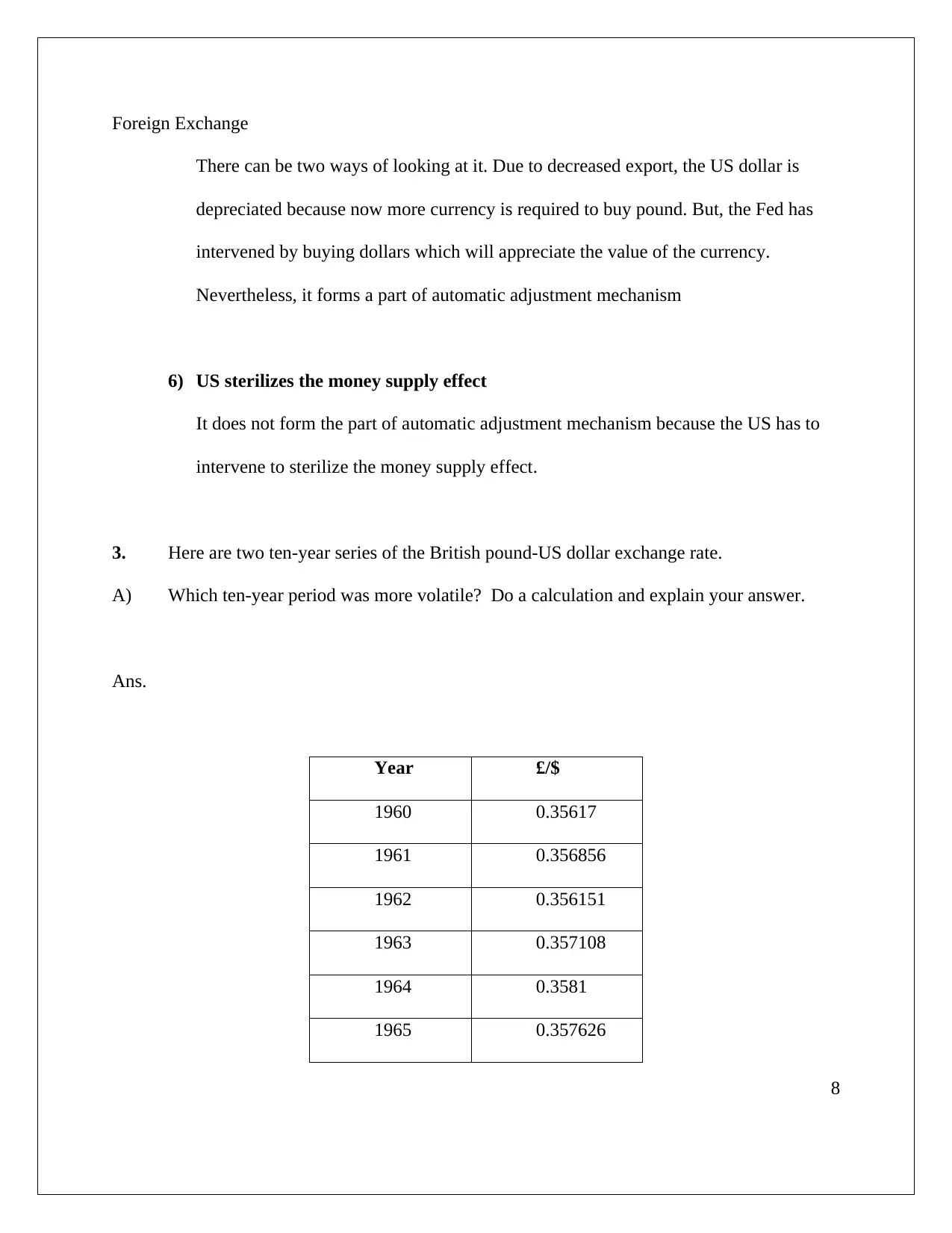
Foreign Exchange
There can be two ways of looking at it. Due to decreased export, the US dollar is
depreciated because now more currency is required to buy pound. But, the Fed has
intervened by buying dollars which will appreciate the value of the currency.
Nevertheless, it forms a part of automatic adjustment mechanism
6) US sterilizes the money supply effect
It does not form the part of automatic adjustment mechanism because the US has to
intervene to sterilize the money supply effect.
3. Here are two ten-year series of the British pound-US dollar exchange rate.
A) Which ten-year period was more volatile? Do a calculation and explain your answer.
Ans.
Year £/$
1960 0.35617
1961 0.356856
1962 0.356151
1963 0.357108
1964 0.3581
1965 0.357626
8
There can be two ways of looking at it. Due to decreased export, the US dollar is
depreciated because now more currency is required to buy pound. But, the Fed has
intervened by buying dollars which will appreciate the value of the currency.
Nevertheless, it forms a part of automatic adjustment mechanism
6) US sterilizes the money supply effect
It does not form the part of automatic adjustment mechanism because the US has to
intervene to sterilize the money supply effect.
3. Here are two ten-year series of the British pound-US dollar exchange rate.
A) Which ten-year period was more volatile? Do a calculation and explain your answer.
Ans.
Year £/$
1960 0.35617
1961 0.356856
1962 0.356151
1963 0.357108
1964 0.3581
1965 0.357626
8
⊘ This is a preview!⊘
Do you want full access?
Subscribe today to unlock all pages.

Trusted by 1+ million students worldwide
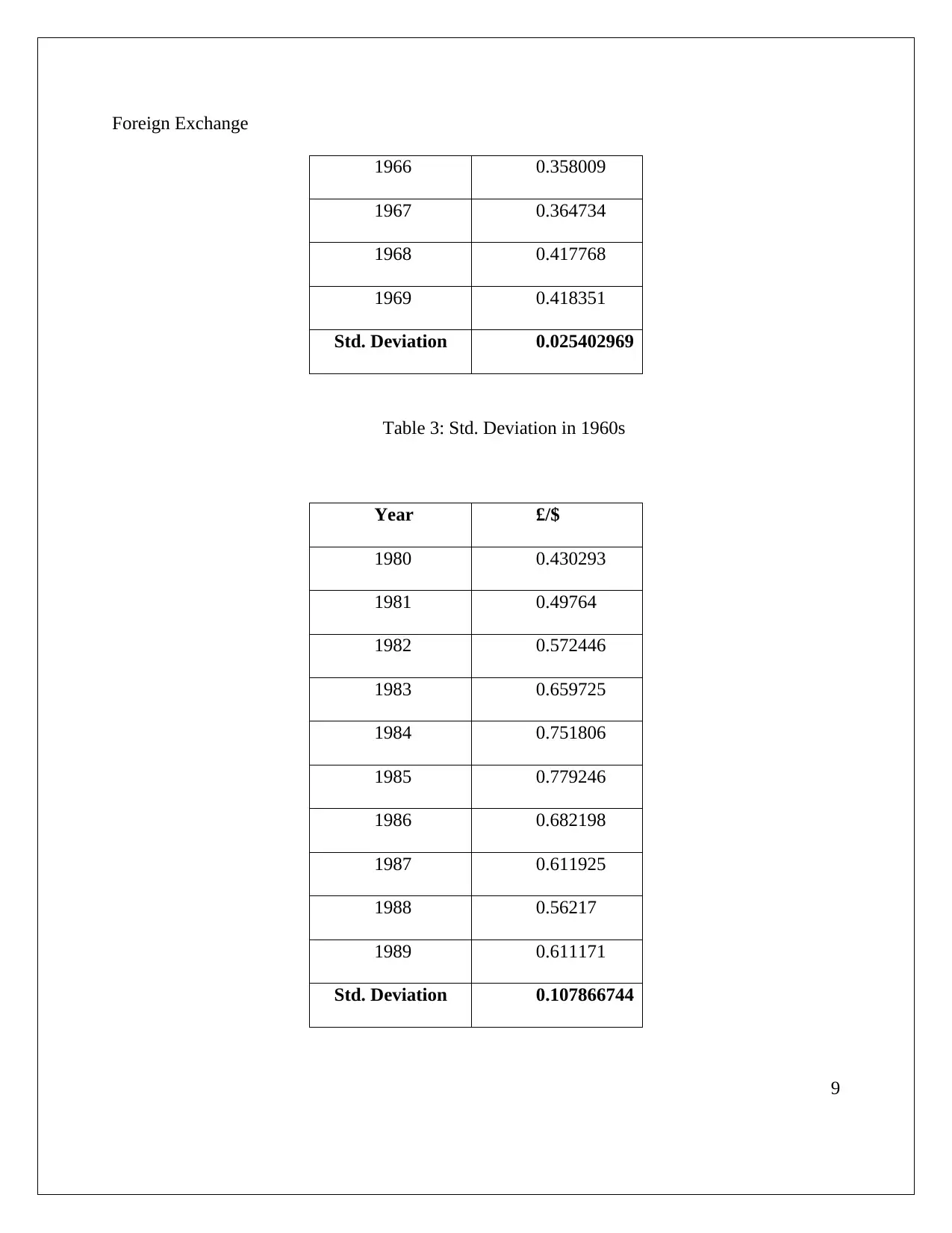
Foreign Exchange
1966 0.358009
1967 0.364734
1968 0.417768
1969 0.418351
Std. Deviation 0.025402969
Table 3: Std. Deviation in 1960s
Year £/$
1980 0.430293
1981 0.49764
1982 0.572446
1983 0.659725
1984 0.751806
1985 0.779246
1986 0.682198
1987 0.611925
1988 0.56217
1989 0.611171
Std. Deviation 0.107866744
9
1966 0.358009
1967 0.364734
1968 0.417768
1969 0.418351
Std. Deviation 0.025402969
Table 3: Std. Deviation in 1960s
Year £/$
1980 0.430293
1981 0.49764
1982 0.572446
1983 0.659725
1984 0.751806
1985 0.779246
1986 0.682198
1987 0.611925
1988 0.56217
1989 0.611171
Std. Deviation 0.107866744
9
Paraphrase This Document
Need a fresh take? Get an instant paraphrase of this document with our AI Paraphraser
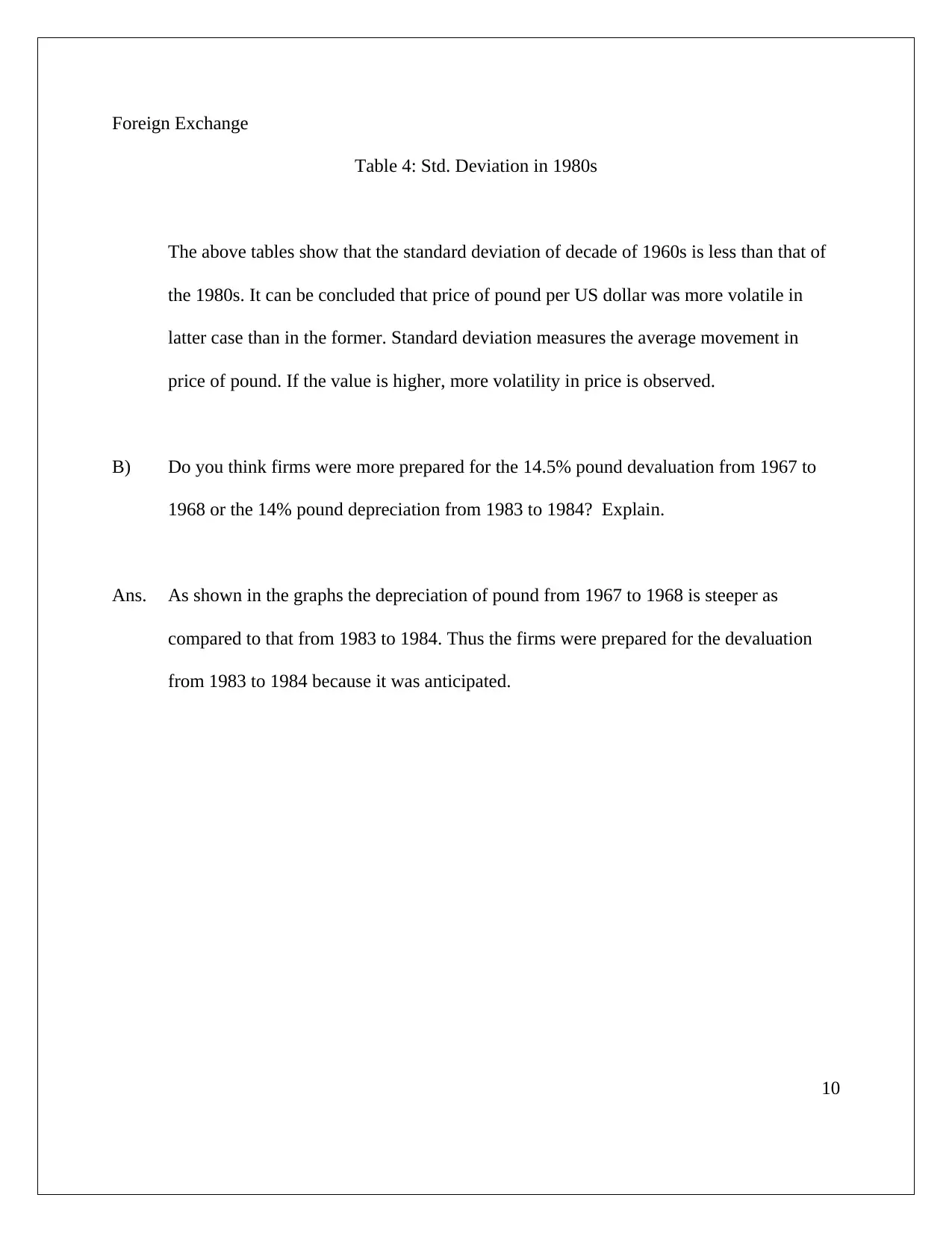
Foreign Exchange
Table 4: Std. Deviation in 1980s
The above tables show that the standard deviation of decade of 1960s is less than that of
the 1980s. It can be concluded that price of pound per US dollar was more volatile in
latter case than in the former. Standard deviation measures the average movement in
price of pound. If the value is higher, more volatility in price is observed.
B) Do you think firms were more prepared for the 14.5% pound devaluation from 1967 to
1968 or the 14% pound depreciation from 1983 to 1984? Explain.
Ans. As shown in the graphs the depreciation of pound from 1967 to 1968 is steeper as
compared to that from 1983 to 1984. Thus the firms were prepared for the devaluation
from 1983 to 1984 because it was anticipated.
10
Table 4: Std. Deviation in 1980s
The above tables show that the standard deviation of decade of 1960s is less than that of
the 1980s. It can be concluded that price of pound per US dollar was more volatile in
latter case than in the former. Standard deviation measures the average movement in
price of pound. If the value is higher, more volatility in price is observed.
B) Do you think firms were more prepared for the 14.5% pound devaluation from 1967 to
1968 or the 14% pound depreciation from 1983 to 1984? Explain.
Ans. As shown in the graphs the depreciation of pound from 1967 to 1968 is steeper as
compared to that from 1983 to 1984. Thus the firms were prepared for the devaluation
from 1983 to 1984 because it was anticipated.
10

Foreign Exchange
Figure 2: Trend in 1960s
Figure 3: Trend in 1980s
11
Figure 2: Trend in 1960s
Figure 3: Trend in 1980s
11
⊘ This is a preview!⊘
Do you want full access?
Subscribe today to unlock all pages.

Trusted by 1+ million students worldwide
1 out of 17
Related Documents
Your All-in-One AI-Powered Toolkit for Academic Success.
+13062052269
info@desklib.com
Available 24*7 on WhatsApp / Email
![[object Object]](/_next/static/media/star-bottom.7253800d.svg)
Unlock your academic potential
Copyright © 2020–2025 A2Z Services. All Rights Reserved. Developed and managed by ZUCOL.





